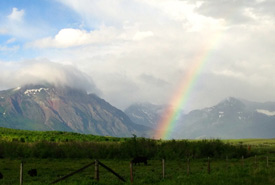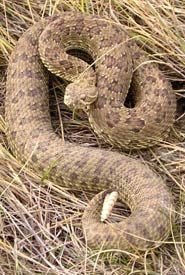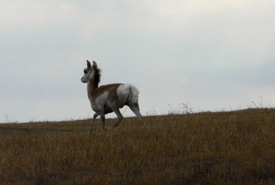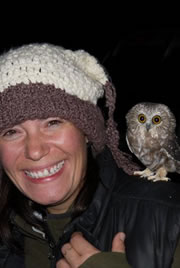The farm kid gets a job

Rainbow at Waterton, AB (Photo by Wonnita Andrus/NCC staff)
Bindloss, Alberta is the sort of place where cows outnumber the people 100 to one. You probably haven’t heard of it, won’t find it on most maps and are unlikely to ever need to visit. Its remoteness is…well…remote. So why, you may ask, does my heart wax nostalgic at the mention of its name or my eyes blur over in a dreamy haze whenever it happens to cross my mind (which is more often than not)?
Let me let you into a little secret…There is no place like my home in southeastern Alberta. It remains one of the biodiversity hotspots in the province, which is a fancy way of saying we have lots of critters there. Ferruginous hawks? Check. Ord’s kangaroo rats, short-horned lizards, moose and pronghorn? Check, check, check, check!
I grew up doing my homework on an hour-and-a-half-long school bus ride with the driver swerving to avoid hog-nosed snakes and mule deer. In retrospect, this explains my terrible cursive writing skills.

Prairie rattlesnake (Photo by Wonnita Andrus/NCC staff)
In Bindloss, burrowing owls were my next door neighbours, couriering insects to their puff ball babies nested in the abandoned badger hole beside the garage. The barbs on the fence to my driveway were host to carcasses of grasshoppers and mice, each which met its demise at the talons of the neighbourhood loggerhead shrikes. Rattlesnakes balled together in the thousands around their winter dens, soaking up the last of the summer sun. Red fox pups scampered around their burrows across the road by the railway tracks. Great horned owls asked the eternal question “Who-Cooks-For-You?” from the trees in our shelterbelts.
How could I not be molded by the drama of fur and feather around me? To this day I still instinctively shake out my boots to dislodge the unexpected guests of black widow spiders, tiger beetles or scorpions.
So the road to becoming a biologist was a natural one, not paved at all, but still built on good intentions.
Like so many rural communities, the larger than life reality of Bindloss became a victim to reality itself. The elevator was torn down. The railway and school was next. Bovine spongiform encephalopathy (BSE) hit hard, forcing folks to sell out. I guess without an economy you can never go home.
Still the wonder that shaped me as a child shapes me as an adult. I have spent my professional life collecting data on gophers and bats, counting snakes and songbirds, tracking deer, black-footed ferrets and turtles. Oh so many other creepy and crawly things have been my companions! But it didn’t take me long to make that connection that many species that were common to see in good ole’ Bindloss, Alberta were also common to see on the endangered species list. And that made me look harder past the symptoms to the disease.

Pronghorn at Bindloss, Alberta (Photo by Wonnita Andrus/NCC staff)
The thing about cows is that you need grass to feed them. Where there is grass there are bugs. Where there are bugs there are birds. Where there are birds there are predators. Where there are predators there are holes and burrows for all the rest to live in.
You want one of these things? Then you need all of these things. It is a simple equation but please note…It starts with the cow. And the cow starts with the rancher. And the rancher starts with the land. And the green grass that grows all around all around…
Which brings me to my job as a Natural Area Manager with the Nature Conservancy of Canada (NCC). Whether I look at the world through my rose-coloured biologist glasses or my green-coloured farm kid glasses I see the same things. Save the land, save the rancher. Save the rancher, save the land.
So here I am. Just a kid raised on grass-fed beef doing her small part to help NCC do its large part in keeping grasslands from being plowed under or built into skyscrapers. I now call the working rangelands of the Waterton Natural Area my home and have traded in rattlesnakes for grizzly bears, but one thing remains unchanged — the cows outnumber the people.
And isn’t that a beautiful thing?


